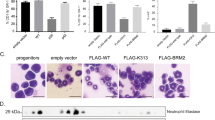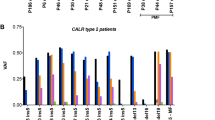Abstract
The receptor tyrosine kinase FLT3 is expressed in myeloid and lymphoid progenitor cells. Activating mutations in FLT3 occur in 25–30% of acute myeloid leukaemia (AML) patients. Most common are internal tandem duplications of sequence (ITD) leading to constitutive FLT3-ITD kinase activity with an altered signalling quality promoting leukaemic cell transformation. Here, we observed the attenuating role of the receptor-like protein tyrosine phosphatase (RPTP) CD45/Ptprc in FLT3 signalling in vivo. Low level expression of this abundant RPTP correlates with a poor prognosis of FLT3-ITD-positive AML patients. To get a further insight into the regulatory role of Ptprc in FLT3-ITD activity in vivo, Ptprc knock-out mice were bred with FLT3-ITD knock-in mice. Inactivation of the Ptprc gene in FLT3-ITD mice resulted in a drastically shortened life span and development of severe monocytosis, a block in B-cell development and anaemia. The myeloproliferative phenotype was associated with extramedullary haematopoiesis, splenohepatomegaly and severe alterations of organ structures. The phenotypic alterations were associated with increased transforming signalling of FLT3-ITD, including activation of its downstream target STAT5. These data reveal the capacity of Ptprc for the regulation of FLT3-ITD signalling activity in vivo. In addition, histopathology and computed tomography (CT) revealed an unexpected bone phenotype; the FLT3-ITD Ptprc-/- mice, but none of the controls, showed pronounced alterations in bone morphology and, in part, apparent features of osteoporosis. In the spleen, ectopic bone formation was observed. The observed bone phenotypes suggest a previously unappreciated capacity of FLT3-ITD (and presumably FLT3) to regulate bone development/remodelling, which is under negative control of CD45/Ptprc.
Key points
-
Low PTPRC expression of FLT3-ITD-positive AML patients correlates with poor prognosis
-
FLT3-ITD/Ptprc-/- mice develop severe monocytosis, a block in B-cell formation and anaemia
-
FLT3-ITD/Ptprc-/- mice develop myeloproliferative neoplasm with extramedullary haematopoiesis and splenohepatomegaly
-
Inactivation of Ptprc in the presence of FLT3-ITD results in cortical porosity and ectopic bone formation
-
Ptprc is negatively regulating transforming FLT3-ITD signalling in vivo
This is a preview of subscription content, access via your institution
Access options
Subscribe to this journal
Receive 50 print issues and online access
$259.00 per year
only $5.18 per issue
Buy this article
- Purchase on Springer Link
- Instant access to full article PDF
Prices may be subject to local taxes which are calculated during checkout







Similar content being viewed by others
References
Papaemmanuil E, Gerstung M, Bullinger L, Gaidzik VI, Paschka P, Roberts ND. et al. Genomic classification and prognosis in acute myeloid leukemia. N Engl J Med. 2016;374:2209–21.
Fröhling S, Scholl C, Levine RL, Loriaux M, Boggon TJ, Bernard OA. et al. Identification of driver and passenger mutations of FLT3 by high-throughput DNA sequence analysis and functional assessment of candidate alleles. Cancer Cell. 2007;12:501–13.
Pinheiro RF, Moreira Ede S, Silva MR, Greggio B, Alberto FL, Chauffaille Mde L. FLT3 mutation and AML/ETO in a case of Myelodysplastic syndrome in transformation corroborates the two hit model of leukemogenesis. Leukemia Res. 2007;31:1015–8.
Stirewalt DL, Radich JP. The role of FLT3 in haematopoietic malignancies. Nat Rev Cancer. 2003;3:650–65.
Mizuki M, Fenski R, Halfter H, Matsumura I, Schmidt R, Müller C. et al. Flt3 mutations from patients with acute myeloid leukemia induce transformation of 32D cells mediated by the Ras and STAT5 pathways. Blood. 2000;96:3907–14.
Hayakawa F, Towatari M, Kiyoi H, Tanimoto M, Kitamura T, Saito H. et al. Tandem-duplicated Flt3 constitutively activates STAT5 and MAP kinase and introduces autonomous cell growth in IL-3-dependent cell lines. Oncogene. 2000;19:624–31.
Godfrey R, Arora D, Bauer R, Stopp S, Muller JP, Heinrich T. et al. Cell transformation by FLT3 ITD in acute myeloid leukemia involves oxidative inactivation of the tumor suppressor protein-tyrosine phosphatase DEP-1/ PTPRJ. Blood. 2012;119:4499–511.
Jayavelu AK, Müller JP, Bauer R, Bohmer SA, Lassig J, Cerny-Reiterer S. et al. NOX4-driven ROS formation mediates PTP inactivation and cell transformation in FLT3ITD-positive AML cells. Leukemia. 2016;30:473–83.
Sallmyr A, Fan J, Datta K, Kim KT, Grosu D, Shapiro P. et al. Internal tandem duplication of FLT3 (FLT3/ITD) induces increased ROS production, DNA damage, and misrepair: implications for poor prognosis in AML. Blood. 2008;111:3173–82.
Lee BH, Tothova Z, Levine RL, Anderson K, Buza-Vidas N, Cullen DE. et al. FLT3 mutations confer enhanced proliferation and survival properties to multipotent progenitors in a murine model of chronic myelomonocytic leukemia. Cancer Cell. 2007;12:367–80.
Li L, Piloto O, Nguyen HB, Greenberg K, Takamiya K, Racke F. et al. Knock-in of an internal tandem duplication mutation into murine FLT3 confers myeloproliferative disease in a mouse model. Blood. 2008;111:3849–58.
Kelly LM, Liu Q, Kutok JL, Williams IR, Boulton CL, Gilliland DG. FLT3 internal tandem duplication mutations associated with human acute myeloid leukemias induce myeloproliferative disease in a murine bone marrow transplant model. Blood. 2002;99:310–8.
Alonso A, Sasin J, Bottini N, Friedberg I, Osterman A, Godzik A. et al. Protein tyrosine phosphatases in the human genome. Cell. 2004;117:699–711.
Östman A, Hellberg C, Böhmer FD. Protein-tyrosine phosphatases and cancer. Nat Rev Cancer. 2006;6:307–20.
Böhmer F, Szedlacsek S, Tabernero L, Ostman A, den Hertog J. Protein tyrosine phosphatase structure-function relationships in regulation and pathogenesis. FEBS J. 2013;280:413–31.
Alexander DR. The CD45 tyrosine phosphatase: a positive and negative regulator of immune cell function. Semin Immunol. 2000;12:349–59.
Hendriks WJ, Pulido R. Protein tyrosine phosphatase variants in human hereditary disorders and disease susceptibilities. Biochim Biophys Acta. 2013;1832:1673–96.
DeFranco AL, Chan VW, Lowell CA. Positive and negative roles of the tyrosine kinase Lyn in B cell function. Semin Immunol. 1998;10:299–307.
Shivtiel S, Kollet O, Lapid K, Schajnovitz A, Goichberg P, Kalinkovich A. et al. CD45 regulates retention, motility, and numbers of hematopoietic progenitors, and affects osteoclast remodeling of metaphyseal trabecules. J Exp Med. 2008;205:2381–95.
Lacombe F, Durrieu F, Briais A, Dumain P, Belloc F, Bascans E. et al. Flow cytometry CD45 gating for immunophenotyping of acute myeloid leukemia. Leukemia. 1997;11:1878–86.
Arora D, Kothe S, van den Eijnden M, Hooft van Huijsduijnen R, Heidel F, Fischer T. et al. Expression of protein-tyrosine phosphatases in Acute Myeloid Leukemia cells: FLT3 ITD sustains high levels of DUSP6 expression. Cell Commun Signal. 2012;10:19
Arora D, Stopp S, Bohmer SA, Schons J, Godfrey R, Masson K. et al. Protein-tyrosine phosphatase DEP-1 controls receptor tyrosine kinase FLT3 signaling. J Biol Chem. 2011;286:10918–29.
Li L, Bailey E, Greenblatt S, Huso D, Small D. Loss of the wild-type allele contributes to myeloid expansion and disease aggressiveness in FLT3/ITD knockin mice. Blood. 2011;118:4935–45.
Pyzer AR, Stroopinsky D, Rajabi H, Washington A, Tagde A, Coll M. et al. MUC1-mediated induction of myeloid-derived suppressor cells in patients with acute myeloid leukemia. Blood. 2017;129:1791–801.
Schmidt-Arras DE, Böhmer A, Markova B, Choudhary C, Serve H, Böhmer FD. Tyrosine phosphorylation regulates maturation of receptor tyrosine kinases. Mol Cell Biol. 2005;25:3690–703.
Choudhary C, Olsen JV, Brandts C, Cox J, Reddy PN, Böhmer FD. et al. Mislocalized activation of oncogenic RTKs switches downstream signaling outcomes. Mol Cell. 2009;36:326–39.
Gabbianelli M, Pelosi E, Montesoro E, Valtieri M, Luchetti L, Samoggia P. et al. Multi-level effects of flt3 ligand on human hematopoiesis: expansion of putative stem cells and proliferation of granulomonocytic progenitors/monocytic precursors. Blood. 1995;86:1661–70.
Rusten LS, Lyman SD, Veiby OP, Jacobsen SE. The FLT3 ligand is a direct and potent stimulator of the growth of primitive and committed human CD34 + bone marrow progenitor cells in vitro. Blood. 1996;87:1317–25.
Lee NK, Sowa H, Hinoi E, Ferron M, Ahn JD, Confavreux C. Endocrine regulation of energy metabolism by the skeleton. Cell. 2007;130:456–69.
Gilliland DG, Griffin JD. The roles of FLT3 in hematopoiesis and leukemia. Blood. 2002;100:1532–42.
Rasko JE, Metcalf D, Rossner MT, Begley CG, Nicola NA. The flt3/flk-2 ligand: receptor distribution and action on murine haemopoietic cell survival and proliferation. Leukemia. 1995;9:2058–66.
Voronov I, Manolson MF. Editorial: Flt3 ligand-friend or foe? J Leukocyte Biol. 2016;99:401–3.
Schulte C, Beelen DW, Schaefer UW, Mann K. Bone loss in long-term survivors after transplantation of hematopoietic stem cells: a prospective study. Osteoporos Int. 2000;11:344–53.
Ebeling PR, Thomas DM, Erbas B, Hopper JL, Szer J, Grigg AP. Mechanisms of bone loss following allogeneic and autologous hemopoietic stem cell transplantation. J Bone Miner Res. 1999;14:342–50.
Zhu JW, Brdicka T, Katsumoto TR, Lin J, Weiss A. Structurally distinct phosphatases CD45 and CD148 both regulate B cell and macrophage immunoreceptor signaling. Immunity. 2008;28:183–96.
Verhaak RG, Wouters BJ, Erpelinck CA, Abbas S, Beverloo HB, Lugthart S. et al. Prediction of molecular subtypes in acute myeloid leukemia based on gene expression profiling. Haematologica. 2009;94:131–4.
Acknowledgements
We are thankful to Jörg Cammenga (Lund University, Sweden) for kindly providing FLT3-ITD mice and Klaus Metzeler for providing array data. The work was supported by Deutsche Forschungsgemeinschaft (grant Mu955/11-1), the Federal Ministry of Education and Research (BMBF), Germany, CancerTel-Sys (FKZ 01ZX1302B, 01ZX1602B) and IFB/CSCC (01EO1002, 01EO1502).
Author information
Authors and Affiliations
Contributions
AK, JPM performed the research; VA, RK processed bioinformatics; BH, CMS, MTF processed CT data; TMS, FH, FDB, JPM analysed and interpreted the data; IDJ, LH, FDB, FH, JPM designed and conceptualised the research; AK, MR, FDB, FH, JPM wrote the manuscript. All the authors read and approved the manuscript.
Corresponding author
Ethics declarations
Conflict of interest
The authors declare that they have no conflict of interest.
Additional information
Publisher’s note: Springer Nature remains neutral with regard to jurisdictional claims in published maps and institutional affiliations.
Supplementary information
Rights and permissions
About this article
Cite this article
Kresinsky, A., Schnöder, T.M., Jacobsen, I.D. et al. Lack of CD45 in FLT3-ITD mice results in a myeloproliferative phenotype, cortical porosity, and ectopic bone formation. Oncogene 38, 4773–4787 (2019). https://doi.org/10.1038/s41388-019-0757-y
Received:
Revised:
Accepted:
Published:
Issue Date:
DOI: https://doi.org/10.1038/s41388-019-0757-y



